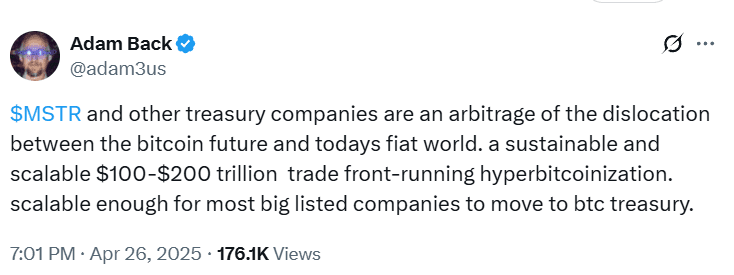Adam Back, co-founder and CEO of Blockstream and inventor of Hashcash, suggests that investment firms with Bitcoin-focused treasuries are leading the way towards global Bitcoin adoption. This adoption, according to Back, could potentially drive Bitcoin’s market capitalization to $200 trillion within the next decade.
Back highlights that institutions and governments are increasingly recognizing Bitcoin’s distinct monetary characteristics. He sees companies like MicroStrategy ($MSTR) leveraging the difference between Bitcoin’s future value and the current fiat system.
“$MSTR and other treasury companies are an arbitrage of the dislocation between the bitcoin future and todays fiat world,” Back stated in an April 26 X post. He anticipates a “sustainable and scalable $100-$200 trillion trade front-running hyperbitcoinization.”
Understanding Hyperbitcoinization
Hyperbitcoinization is the theoretical scenario where Bitcoin becomes the dominant global currency, surpassing fiat money due to its limited supply and growing distrust in traditional financial systems.

According to Back, Bitcoin’s price appreciation outpacing fiat currency inflation is a primary catalyst for global hyperbitcoinization. He views the treasury strategy adopted by some companies not as a temporary anomaly, but as a logical arbitrage opportunity driven by Bitcoin’s increasing value over time.
National Bitcoin Reserve
While the original article mentions a supposed executive order from Donald Trump to establish a national Bitcoin reserve, it’s important to note that there’s no credible evidence to support the existence of such an order. This claim appears to be inaccurate or speculative.
Corporate Bitcoin Accumulation
Companies like MicroStrategy continue to accumulate Bitcoin, which could influence other firms to follow suit. MicroStrategy’s Bitcoin treasury has reportedly generated substantial profits, showcasing the potential benefits of this strategy.

Metaplanet, a Japanese investment firm, has adopted a similar strategy, acquiring over 5,000 BTC and aiming for 21,000 BTC by 2026. This demonstrates the growing interest in Bitcoin as a corporate treasury asset, particularly in Asia.
Factors Driving Bitcoin Adoption
Several factors are contributing to increased Bitcoin adoption:
- Limited Supply: Bitcoin’s capped supply of 21 million coins makes it a hedge against inflation.
- Decentralization: Bitcoin operates independently of central banks and governments, providing greater financial freedom.
- Growing Institutional Interest: More companies and institutions are investing in Bitcoin, increasing its legitimacy and stability.
- Technological Advancements: Improvements in Bitcoin’s infrastructure and scalability are making it more accessible and usable.
Risks and Challenges
Despite the potential benefits, investing in Bitcoin also carries risks:
- Volatility: Bitcoin’s price can fluctuate significantly, leading to potential losses.
- Regulatory Uncertainty: The regulatory landscape for Bitcoin is still evolving, which could impact its future.
- Security Risks: Bitcoin exchanges and wallets are vulnerable to hacking and theft.
Conclusion
Adam Back’s vision of a $200 trillion Bitcoin market capitalization is ambitious, but it reflects the growing belief in Bitcoin’s potential to become a dominant global currency. While risks and challenges remain, the increasing adoption by institutions and individuals suggests that Bitcoin is poised for further growth in the coming years.